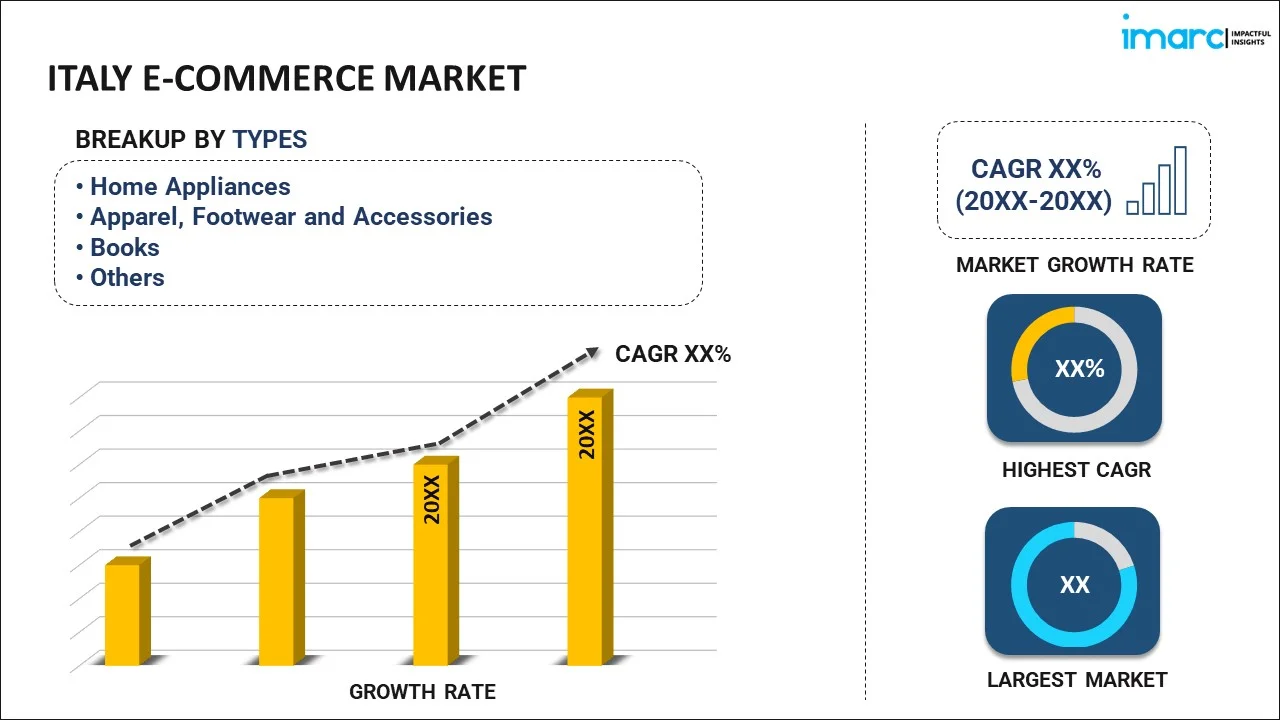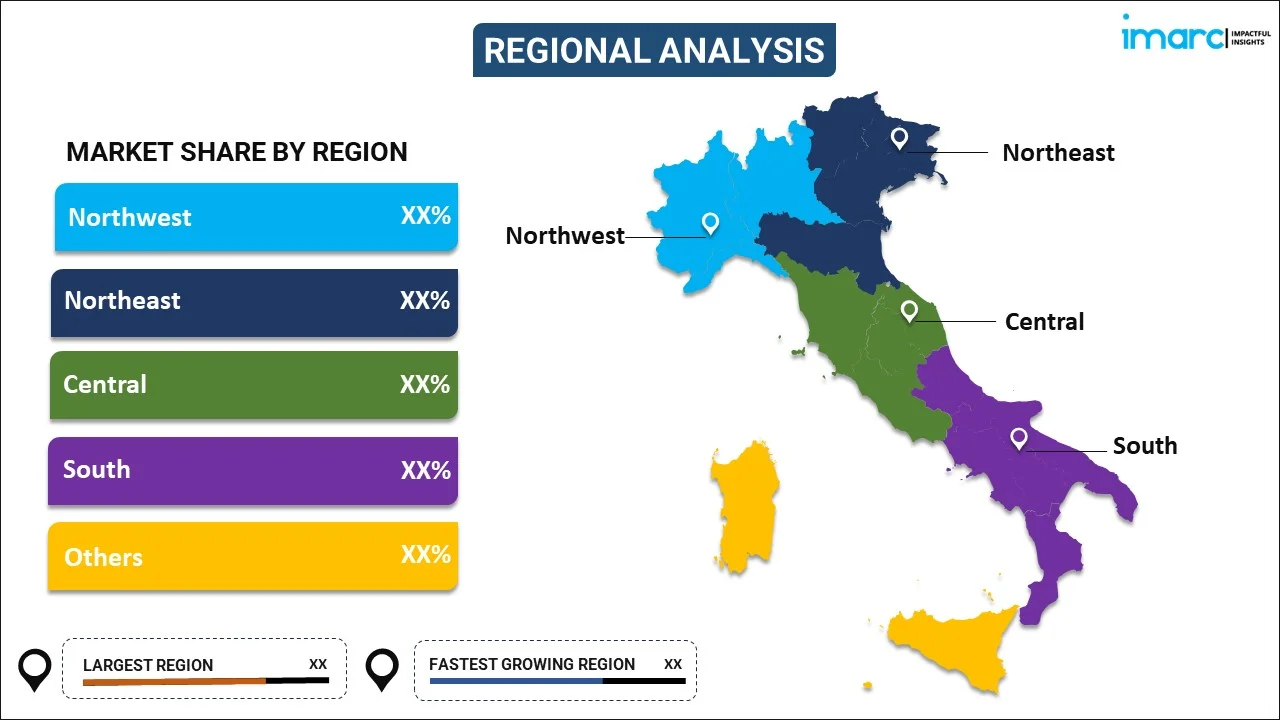
Italy E-commerce Market Report by Type (Home Appliances, Apparel, Footwear and Accessories, Books, Cosmetics, Groceries, and Others), Transaction (Business-to-Consumer, Business-to-Business, and Others), and Region 2025-2033
Italy E-commerce Market Overview:
The Italy e-commerce market size is projected to exhibit a growth rate (CAGR) of 8.17% during 2025-2033. The rising internet penetration and smartphone usage among the masses, rising changes in customer behavior caused by the presence of online platforms, and heightened expansion in logistics operations and payment infrastructure are bolstering the market growth.
|
Report Attribute
|
Key Statistics
|
|---|---|
|
Base Year
|
2024 |
|
Forecast Years
|
2025-2033 |
|
Historical Years
|
2019-2024
|
| Market Growth Rate (2025-2033) | 8.17% |
Italy E-commerce Market Trends:
Increasing Internet Penetration and Smartphone Usage
One of the most significant drivers of the e-commerce market in Italy is the widespread adoption of the internet and smartphones. As of recent data, Italy has seen a substantial increase in internet users. This rise in connectivity has facilitated greater access to online platforms, making it easier for people to engage in e-commerce activities. Smartphones, in particular, have become a pivotal tool for online shopping, with a significant portion of the population using them for browsing and purchasing products. Mobile commerce (m-commerce) has been on an upward trajectory, driven by advancements in mobile technology and user-friendly apps that enhance the shopping experience. Retailers are increasingly optimizing their websites for mobile use and developing dedicated apps to capture this growing segment. The convenience of shopping on-the-go, coupled with secure mobile payment options, is further impelling the market growth in Italy.
Evolving Customer Behavior
Italy's consumer behavior changed dramatically, which exerted a big impact on the e-commerce sector. The need for convenience, variety, and affordable prices is causing a discernible shift in the behavior of people toward online buying. Because of their rising trust in online platforms and their favorable experiences, Italian customers are becoming increasingly accustomed to conducting business online. Furthermore, there is a heightened trend in favor of foreign brands and goods that might not be easily found in local marketplaces. Many Italian consumers find e-commerce to be an appealing alternative due to their need for variety as well as the chance to compare prices and read online reviews. Additionally, social media and influencer marketing are vital in influencing customer choices and increasing traffic to e-commerce websites, underscoring the significance of having a strong digital
Expanding Logistics and Payment Infrastructure
The development of logistics and payment infrastructure in Italy is another critical factor contributing to the growth of the market. Online retailers need delivery systems that are dependable and efficient, and Italy has made great progress in this regard. To accommodate the rising demand, major logistics corporations as well as local competitors have made investments in network expansion and improved last-mile delivery options. For example, in 2024, Cosco and Fratelli Cosulich purchased a logistics company in Trasgo that was situated in Novara. Trasgo is a global leader in integrated logistics, and as the company evolved, it effectively increased its reach.
Innovations, such as automated warehouses and real-time tracking systems enhance the overall efficiency of the supply chain, ensuring timely delivery and better customer satisfaction. On the payment side, the proliferation of secure and convenient payment options has removed a significant barrier to online shopping. Italian consumers now have access to a variety of payment methods, including credit and debit cards, digital wallets, and even cash-on-delivery in some cases. The integration of advanced fraud detection systems and the introduction of EU-wide regulations are boosting buyer confidence in the security of online transactions.
Italy E-commerce Market News:
- June 2024: Coop Alleanza launched a unique and advanced e-commerce service to enhance its online buyer’s experience.
Italy E-commerce Market Segmentation:
IMARC Group provides an analysis of the key trends in each segment of the market, along with forecasts at the country level for 2025-2033. Our report has categorized the market based on type and transaction.
Type Insights:

- Home Appliances
- Apparel, Footwear and Accessories
- Books
- Cosmetics
- Groceries
- Others
The report has provided a detailed breakup and analysis of the market based on the type. This includes home appliances, apparel, footwear and accessories, books, cosmetics, groceries, and others.
Transaction Insights:
- Business-to-Consumer
- Business-to-Business
- Others
A detailed breakup and analysis of the market based on the transaction have also been provided in the report. This includes business-to-consumer, business-to-business, and others.
Regional Insights:

- Northwest
- Northeast
- Central
- South
- Others
The report has also provided a comprehensive analysis of all the major regional markets, which include Northwest, Northeast, Central, South, and Others.
Competitive Landscape:
The market research report has also provided a comprehensive analysis of the competitive landscape in the market. Competitive analysis such as market structure, key player positioning, top winning strategies, competitive dashboard, and company evaluation quadrant has been covered in the report. Also, detailed profiles of all major companies have been provided.
Italy E-commerce Market Report Coverage:
| Report Features | Details |
|---|---|
| Base Year of the Analysis | 2024 |
| Historical Period | 2019-2024 |
| Forecast Period | 2025-2033 |
| Units | Billion USD |
| Scope of the Report | Exploration of Historical and Forecast Trends, Industry Catalysts and Challenges, Segment-Wise Historical and Predictive Market Assessment:
|
| Types Covered | Home Appliances, Apparel, Footwear and Accessories, Books, Cosmetics, Groceries, Others |
| Transactions Covered | Business-to-Consumer, Business-to-Business, Others |
| Regions Covered | Northwest, Northeast, Central, South, Others |
| Customization Scope | 10% Free Customization |
| Post-Sale Analyst Support | 10-12 Weeks |
| Delivery Format | PDF and Excel through Email (We can also provide the editable version of the report in PPT/Word format on special request) |
Key Questions Answered in This Report:
- How has the Italy E-commerce market performed so far and how will it perform in the coming years?
- What has been the impact of COVID-19 on the Italy E-commerce market?
- What is the breakup of the Italy E-commerce market on the basis of type?
- What is the breakup of the Italy E-commerce market on the basis of transaction?
- What are the various stages in the value chain of the Italy E-commerce market?
- What are the key driving factors and challenges in the Italy E-commerce?
- What is the structure of the Italy E-commerce market and who are the key players?
- What is the degree of competition in the Italy E-commerce market?
Key Benefits for Stakeholders:
- IMARC’s industry report offers a comprehensive quantitative analysis of various market segments, historical and current market trends, market forecasts, and dynamics of the Italy E-commerce market from 2019-2033.
- The research report provides the latest information on the market drivers, challenges, and opportunities in the Italy E-commerce market.
- Porter's five forces analysis assist stakeholders in assessing the impact of new entrants, competitive rivalry, supplier power, buyer power, and the threat of substitution. It helps stakeholders to analyze the level of competition within the Italy E-commerce industry and its attractiveness.
- Competitive landscape allows stakeholders to understand their competitive environment and provides an insight into the current positions of key players in the market.
Need more help?
- Speak to our experienced analysts for insights on the current market scenarios.
- Include additional segments and countries to customize the report as per your requirement.
- Gain an unparalleled competitive advantage in your domain by understanding how to utilize the report and positively impacting your operations and revenue.
- For further assistance, please connect with our analysts.
 Inquire Before Buying
Inquire Before Buying
 Speak to an Analyst
Speak to an Analyst
 Request Brochure
Request Brochure
 Request Customization
Request Customization




.webp)




.webp)












